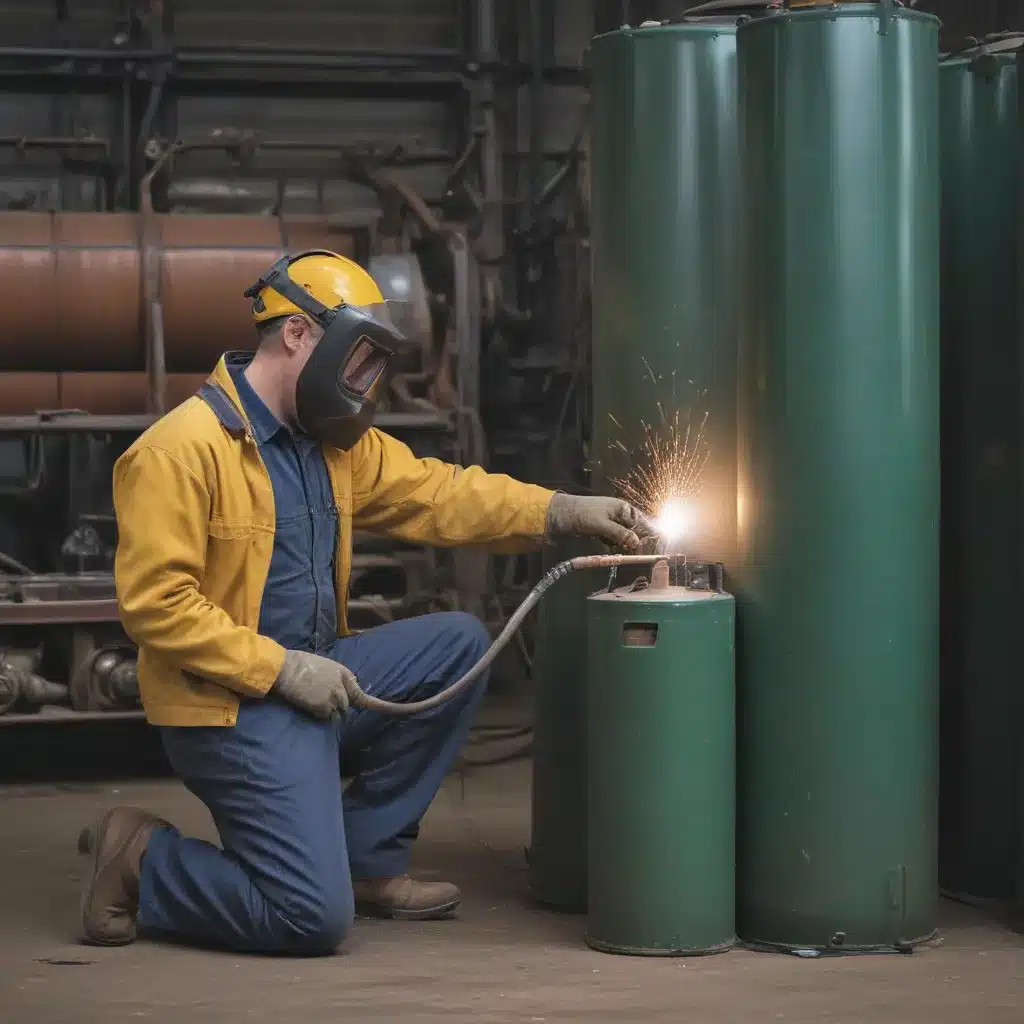
Navigating the Perilous World of Welding Gases
Ah, the world of welding – where sparks fly, metal mingles, and the occasional whiff of singed eyebrows hangs in the air. As a seasoned welding aficionado, I’ve seen it all, from the triumphant fusion of steel to the, ahem, less graceful moments where the only thing being forged is a new personal hairstyle. But amidst the thrill of the torch, there’s one aspect of welding that demands our utmost attention: the safe handling of those mysterious, often invisible, welding gases.
You see, these compressed canisters of wonder can be a real double-edged sword. Treat them with the respect they deserve, and they’ll be your trusty sidekicks, helping you achieve flawless welds. But neglect the proper safety protocols, and well, let’s just say you might find yourself in a real-life version of “The Incredible Hulk” – except instead of turning green, you’re turning various shades of singed.
Understanding the Basics of Welding Gases
Now, before we dive into the nitty-gritty of gas handling, let’s take a step back and explore the different types of welding gases you’re likely to encounter. We’ve got the classic inert gases like argon and helium, which are used to shield the weld from pesky atmospheric oxygen and nitrogen. Then there are the active gases like carbon dioxide and oxygen, which can be added to the mix to fine-tune the welding process.
But here’s the kicker – these gases, while essential for our craft, can also be downright dangerous if not handled properly. Imagine a world where your trusty welding buddy is secretly a supervillain, ready to unleash its nefarious powers at the slightest provocation. That’s kind of what we’re dealing with here, folks.
Proper Storage and Handling Techniques
So, how do we tame these unruly welding gases and ensure they stay firmly on the side of good? Well, my friends, it all comes down to proper storage and handling techniques. First and foremost, always store your gas cylinders upright and secured to a stable surface. This prevents them from toppling over and potentially causing a catastrophic release of pressure.
And speaking of pressure, you’ll want to keep a close eye on those gauges. Never, and I mean never, attempt to refill or tamper with the cylinders themselves. That’s a job best left to the professionals. Instead, when it’s time to swap out an empty cylinder, make sure you shut off the gas supply, bleed the line, and then carefully disconnect the regulator.
Transporting Welding Gases Safely
But the adventure doesn’t end there, my friends. Oh no, we’ve got to tackle the tricky task of transporting these temperamental gas containers. Now, I know what you’re thinking – “How hard can it be? Just toss ’em in the back of the truck and hit the road!” Well, hold on to your welding gloves, because that’s a surefire way to end up in a real-life version of “The Fast and the Furious: Welding Gas Edition.”
Instead, make sure you secure those cylinders properly, using the appropriate straps or chains to keep them upright and steady. And never, ever, transport them in the same vehicle as flammable liquids or ignition sources. That’s a recipe for a fireworks display that even the Fourth of July would be jealous of.
Proper Usage and Maintenance
Alright, now that we’ve got the storage and transport sorted out, let’s dive into the nitty-gritty of actually using these welding gases. First and foremost, always, always, always make sure you’re working in a well-ventilated area. These gases can displace oxygen, and the last thing you want is to be sucking in pure nitrogen and thinking you’re the next Olympian.
And speaking of oxygen, be mindful of your regulators and hoses. Make sure they’re in good working order and don’t show any signs of wear or damage. Trust me, you don’t want to be the one who discovers a pinhole leak the hard way. And when it’s time to switch out that empty cylinder, remember those safety steps we covered earlier – shut off the gas, bleed the line, and then disconnect.
Handling Emergencies and Leaks
But let’s be real, even with all the precautions in the world, sometimes things can still go awry. And when it comes to welding gases, those “awry” moments can get pretty darn serious, pretty darn quick. So, what do you do if you suspect a gas leak? First and foremost, evacuate the area immediately. Don’t try to be a hero and fix it yourself – that’s a job for the professionals.
Once you’re a safe distance away, call the authorities and let them handle the situation. And if you happen to be on the receiving end of a nasty exposure, seek medical attention right away. These gases can have some pretty nasty effects, from respiratory distress to, well, let’s just say you don’t want to find out the hard way.
Conclusion: Embracing Safety for a Lifetime of Welding
At the end of the day, the key to safely handling welding gases and containers is a combination of knowledge, vigilance, and a healthy respect for the power these compressed canisters of wonder can wield. By following the proper protocols, staying alert, and never taking shortcuts, you can ensure that your welding adventures are filled with triumph, not tragedy.
So, my fellow welding enthusiasts, let’s raise our torches high and celebrate the art of metalworking – but let’s do it safely, shall we? After all, the only thing we should be forging is a lifetime of incredible welds, not a new and unexpected personal hairstyle. Happy welding, my friends!
Oh, and before I forget, if you’re in the market for top-notch welding services, be sure to check out https://www.corrconnect.org/. These folks know their stuff when it comes to arc welding, metal cutting, custom fabrication, and precision welding. Trust me, you won’t be disappointed!
